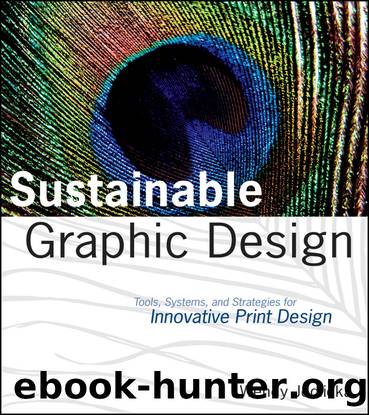Sustainable Graphic Design: Tools, Systems, and Strategies for Innovative Print Design by Wendy Jedlicka

Author:Wendy Jedlicka [Jedlička, Wendy]
Language: eng
Format: epub
ISBN: 9780470640272
Publisher: Wiley
Published: 2013-01-08T00:00:00+00:00
Paper and paperboard recovery in the United States, according to the EPA report, rose to over 54.4 percent; metals were recycled at a rate over 34 percent, while about 64 percent of yard trimmings were recovered. Commonly used metals like aluminum and steel can be recycled into new products and packaging nearly indefinitely. Their low recovery rate then adds insult to injury, locking up otherwise super valuable materials in landfills, rather than keeping them in a useful closed-loop system (Cradle to Cradle technical nutrient). In addition to maintaining access to these valuable resources, by recycling nearly 7 million tons of metals the EPA calculates Americans eliminated what would otherwise have been about 6.5 million metric tons of carbon equivalent (MMTCE) greenhouse gas (GHG) emissions. This is equivalent to removing more than 5 million cars from the road for one year. Imagine the impacts if the recycling rates for metals were at 100 percent!
In an effort to encourage better consumer participation in recycling, starting in 2009 many of the pet food brands manufactured by Purina (the largest maker of canned pet food in the Unites States) will begin allocating label space for stronger recycling messages. Given the small physical size of some of their canned products this is a really big deal. Purina packaging with a bit more area to play with will feature âdid you knowâ facts to help further consumerâs recycling awareness. Facts like, âDid you know making a ânewâ aluminum can from recycled aluminum takes 95 percent less energy than producing the same can from virgin ore?ââwill help the consumer better connect with their part in a productâs life cycle, and how their participation really does make a significant difference in resource use.
Mark Brodeur, Director of Sustainability for Purina PetCare North America notes, âItâs our responsibility to educate and engage consumers on the many benefits of recycling our cans ⦠As the largest manufacturer of wet pet food in the U.S., we produced over 3 billion aluminum and steel cans last year, which are 100% recyclable.â4
Looking further at how to improve recycling rates, individual states are taking a much more aggressive stance on resource management, with higher than national average results.
According to the California Department of Conservationâs Six-Month Report of Beverage Container Recycling and Significant Carbon Reductions, the stateâs beverage container recycling rate rose to 76 percent over the study period of January to June 2008, up from 71 percent in 2007, which in turn was up from 65 percent for the same period in 2006. In addition, California figures for glass container recycling continue to be much higher than the national average for the United States. In the United Kingdom, recycling rates for glass containers (e.g., bottles and jars) is around 50 percent. The figure has doubled in recent years but still lags behind other countriesâfor example, Switzerland and Finland recycle more than 90 percent of their glass containers.
According to the 2008 Six-Month Report, each year California consumes 714 million barrels of oil (up from 657 in 2007) and emits 479 million metric tons of greenhouse gases (down from 492 in 2007).
Download
This site does not store any files on its server. We only index and link to content provided by other sites. Please contact the content providers to delete copyright contents if any and email us, we'll remove relevant links or contents immediately.
Wonder by R.J. Palacio(8430)
Mastering Adobe Animate 2023 - Third Edition by Joseph Labrecque(3720)
Unlabel: Selling You Without Selling Out by Marc Ecko(3574)
Ogilvy on Advertising by David Ogilvy(3485)
Hidden Persuasion: 33 psychological influence techniques in advertising by Marc Andrews & Matthijs van Leeuwen & Rick van Baaren(3454)
Drawing Cutting Edge Anatomy by Christopher Hart(3440)
The Pixar Touch by David A. Price(3347)
POP by Steven Heller(3297)
The Code Book by Simon Singh(3057)
The Art of War Visualized by Jessica Hagy(2932)
Slugfest by Reed Tucker(2924)
The Curated Closet by Anuschka Rees(2897)
Rapid Viz: A New Method for the Rapid Visualization of Ideas by Kurt Hanks & Larry Belliston(2815)
Stacked Decks by The Rotenberg Collection(2796)
365 Days of Wonder by R.J. Palacio(2737)
The Wardrobe Wakeup by Lois Joy Johnson(2717)
Keep Going by Austin Kleon(2682)
Tattoo Art by Doralba Picerno(2583)
Tell Me More by Kelly Corrigan(2579)
